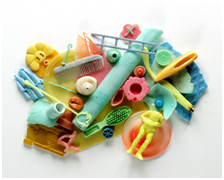Elizabeth Peña
Creating Beauty from Discarded Beach Plastic

“Mining the Collection: Finding Meaning in the Mess”
June 9 – August 28, 2015
Artists’ Talk with Judith Selby Lang and Richard Lang
Tuesday, August 25, 2015, 5:00 – 7:00 pm
Doug Adams Gallery/Badè Museum of Biblical Archaeology
1798 Scenic Avenue, Berkeley, CA
Environmental degradation, air pollution, animal extinction … how can we be good caretakers of our planet without becoming overwhelmed by the magnitude of these issues? How can scholars and religious communities respond to the call issued by 2014 president of the American Academy of Religion and GTU alum, Dr. Laurie Zoloth, to help fight climate change?
Artists Judith Selby Lang and Richard Lang, whose work will be exhibited this summer at the GTU’s Doug Adams Gallery, provide us with a model for engagement. Since 1999, the Langs have been patrolling the 1000 yards of Kehoe Beach, Point Reyes National Seashore in northern California, gathering plastic debris as it washes ashore. Guided by the motto, “beauty first,” the Langs bring attention to the problem of plastic pollution by creating colorful and sensitive artwork out of these plastic remnants.
Because the Langs’ process is archaeological in nature – involving collecting, cleaning, sorting, and organizing artifacts – they are the perfect guest artists for the summer exhibition presented by the GTU’s Center for the Arts, Religion, and Education (CARE) in collaboration with the Badè Museum of Biblical Archaeology (Pacific School of Religion). In this annual summer exhibition series entitled “Mining the Collection,” CARE invites guest artists to work with Badè curators to explore the Museum’s Iron Age Tell en-Nasbeh collection for inspiration.
This year, CARE is proud to present the art of Judith Selby Lang and Richard Lang in “Mining the Collection: Finding Meaning in the Mess.” While the Langs’ artwork is on display in the Doug Adams Gallery, artifacts from the museum collection will be on display in the Badè. Museum. CARE’s annual “Mining the Collection” summer exhibition series is inspired by Fred Wilson’s transformative “Mining the Museum” project at the Maryland Historical Society (1992), which involved presenting traditional museum collections in an alternative light, engendering new understandings.
While the Langs’ work ranges from large collages to jewelry pieces, they often compose arrangements of plastic fragments – based on color, shape, or both – to create large-scale prints. The plastic pieces can then be re-sorted for re-use in future works.
In their artists’ statement for “Mining the Collection: Finding Meaning in the Mess,” the Langs note:
Our search for meaning has taken us from the beach to this august institution, and rightly so. The search for meaning swings toward theology as a way of making sense of an untidy universe.
During our 20-year long project we’ve been on an ongoing quest to find out how an aesthetic mind transforms plastic pollution into something meaningful, something beautiful to see. Along the way we’ve met the texts of powerful thinkers like Mary Douglas, Emile Durkheim, and Mircea Eliade, who all probe the question, what is allowed inside the Temple, the sacred space, and what must remain outside as the profane, as the ”dirt”? We wonder if there is an alchemy in the creative process linked to transformative action?
Judith and Richard speak of alchemy, but most of us can’t turn dross into gold. We can, however, emulate the Langs in thinking about the environment as sacred space and in wrestling with the theological implications of our disregard for environmental stewardship. The people of Tell en-Nasbeh left us pottery sherds and ceramic figurines, but the plastic legacy we leave to future generations will be far more damaging than informative.
For Judith Selby Lang and Richard Lang, art is a means of engagement. We are drawn to their artwork by the beauty of their compositions, then shocked to discover that the source of the beauty is garbage. Their work is a call to action, reminding us of our responsibility to care for our environment and to think about steps we can each take to reduce our participation in our “throwaway” culture.
Elizabeth Peña is the executive director of the GTU’s Center for Arts, Religion, and Education.
